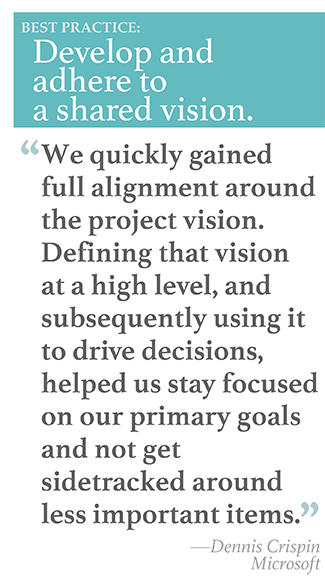
When Microsoft customers want to make a purchase on payment terms outside the standard net-30 or net-60 days, the Worldwide Payment Solutions (WPS) group steps in. “We craft payment solutions that let them pay in a different rhythm,” explains Tom Czerwinski, the director of technology for Microsoft's Worldwide Payment Solutions team. “Our customers may have an unusual consumption pattern, or perhaps large seasonal swings in business. We help them pay in non-standard ways.”
The group's most popular solution is the extended payment terms, or XPT, program. XPT enables Microsoft to extend longer terms to prospective customers without resorting to independently negotiated loan agreements. Thus, it helps the company seamlessly integrate flexible payment terms into eligible licensing enrollments or services agreements for credit-qualified customers.
XPT has always been a boon to Microsoft's U.S.-based sales force, but a couple of years ago, the program's scope was limited. The Microsoft WPS team handled origination of XPT contracts, including credit decisioning, pricing, documentation, and internal approvals. Meanwhile, an external service provider handled collections for the program, operating its own subledger for the booking, billing, and cash application of XPT transactions. The collections outsourcer did not operate outside the United States. “We aspired to expand globally, and our service provider couldn't do that,” Czerwinski says.
The legacy XPT processes also faced an array of efficiency challenges. One problem was that WPS staff had to log into multiple software systems and perform manual activities at each step of the origination process. They obtained approvals through email or chat applications, and they often needed to find necessary documentation in Word or Excel documents, PDF files, and emails. At the same time, data from the subledger of the collections outsourcer came back into Microsoft's books only through manual journal entries.
The siloed processes limited visibility into both individual transactions and the program as a whole. And all the manual work opened the company to risk of human error, while creating compliance and audit challenges, as well.
“We needed to shift our technology to support a straight-through process that could better scale with our growth plans,” Czerwinski says. “We also needed a business process outsourcing vendor that could expand with us globally. So, we needed to entirely revamp the XPT program—to throw away the existing toolsets and create a new set of tools to support the program's future.”
WPS launched this project by benchmarking the XPT program's legacy processes against those of similar functions within Microsoft. This benchmarking revealed that the customer experience was very different for purchases with extended payment terms than for purchases with standard terms.
“Some of our customers had some transactions on standard payment terms and other deals on XPT, and the two programs had completely different customer service experiences,” recounts Dennis Crispin, a senior manager for technology in the Worldwide Payment Solutions group. “Our benchmarking evaluated how we could improve customer service, and we realized that we needed to standardize our processes to provide a consistent and reliable credit and collections experience regardless of payment terms.”
WPS pulled together a project team to select and on-board a new collections service provider with a broader geographic perspective. They also planned to develop a new XPT origination application that would serve as a single version of the truth throughout the lifecycle of an XPT transaction. The tool needed to provide straight-through processing with Microsoft's SAP enterprise resource planning (ERP) system, as well as consistency with the processes and technologies supporting Microsoft's standard-payment-terms financing. It would be called Single Point of Contract, or SPOC.
 The core project team worked closely with staff from Microsoft's global financing desk, products and pricing, operations, treasury, compliance, accounting, and IT. As the initiative got under way, team-building was crucial. “We dedicated significant effort up front to building trust and collaboration,” Czerwinski says. “I had just started with WPS. Other people had just experienced a reorganization and mission change. And we were asking them to support this project that would disrupt their business processes and system landscape. Building a cohesive team from the very beginning was a big factor in our ability to build out the application quickly.”
The core project team worked closely with staff from Microsoft's global financing desk, products and pricing, operations, treasury, compliance, accounting, and IT. As the initiative got under way, team-building was crucial. “We dedicated significant effort up front to building trust and collaboration,” Czerwinski says. “I had just started with WPS. Other people had just experienced a reorganization and mission change. And we were asking them to support this project that would disrupt their business processes and system landscape. Building a cohesive team from the very beginning was a big factor in our ability to build out the application quickly.”
Another factor was the project's clearly defined vision. Czerwinski says that early on, during informal conversations outside of team meetings, he and another project leader articulated a shared vision for what they were trying to accomplish with the project. “Our shared vision was a tipping point,” he says. “We were able to show others the value in the change and what the solution could do for their teams. Within about two weeks, we had everyone on the core team aligned. At that point, they were not only supporting the project goals, but also championing the vision to external stakeholders.”
“We quickly gained full alignment around the project vision with our VP and the stakeholders in all the departments that would be impacted,” Crispin adds. “Defining that vision at a high level, and subsequently using it to drive decisions, helped us stay focused on our primary goals and not get sidetracked around less important items.”
Additional factors driving the initiative's success were the team's adoption of an Agile project management methodology and focus on providing a “minimum viable product” first, to be enhanced once the basics are functional. “With the MVP approach, you're building the shell of what's required,” Czerwinski explains. “Then you can expand that shell in your subsequent releases, to build out the broader set of capabilities that you envision.”
The first version of SPOC was delivered within four months of the project's kickoff. The next quarter was focused on enhancing SPOC, on-boarding a new service provider with the capability to expand XPT globally, and configuring an SAP module to support the program's specific servicing requirements. Four months after that, the entire multibillion-dollar XPT accounts receivable (A/R) portfolio had been migrated to the new processes. “We continue to build out SPOC and add new capabilities,” Czerwinski says, “but we had the first version up and running very quickly.”
Today, when a Microsoft salesperson identifies extended-terms financing as a potential need in a sales negotiation, a credit request is created in SPOC. The system attempts to calculate a debt rating. “The goal is to automate determinations of creditworthiness whenever possible,” Czerwinski says. When the system can't automatically pull all the information needed for the scoring algorithm, the credit request heads to a manual process entailing a WPS employee's review of customer financials.
After the debt rating is established, SPOC continues to monitor factors that would affect the customer's creditworthiness. It also performs validations to make sure the transaction is fully compliant with Microsoft policies. “We have been able to use technology to help ensure compliance since the beginning of the application,” says Dave O'Hara, corporate vice president of Worldwide Commercial Finance at Microsoft. “This fits into the culture within our organization and helps ensure we are making sound business decisions.”
See also:
- Webcast: Successful Treasury Transformation and Innovation through Technology Excellence
- APIs Automate Booking of Payments that Defy Standardization
- Retooling Processes to Improve Productivity and ROI
As a purchase is finalized, SPOC then tracks the booking and funding of the transaction. “Although the movement of the money happens elsewhere, SPOC is communicating back and forth with our ERP system so that people can track the status of every XPT transaction in one location,” Czerwinski adds.
The new collections outsourcer does not maintain an external subledger for XPT transaction servicing; instead, its subledger resides in the SAP module that the WPS team implemented. Account postings are automated, processes are standardized, and redundant activities have been eliminated.
To effectively and efficiently respond to user questions about XPT, the project team customized a Microsoft Azure-based chatbot. The tool uses active learning, an artificial intelligence component, to better understand questions asked in natural language. This helps ensure that answers better meet the questioner's needs. To streamline Q&A deployment, the WPS team connected their chatbot with a similar tool developed by Microsoft's Worldwide Credit Services (WWCS), the group that manages credit and collections for transactions with standard payment terms. Questions and answers already in the WWCS chatbot flow automatically into the WPS tool.
All in all, the project has greatly enhanced efficiency of the XPT program. “We didn't just change how people interact with the system,” Czerwinski says. “We streamlined business processes as well. Now, every credit request goes through the same sequence of Step A before Step B before Step C. Previously, Steps A, B, and C might all have been running in parallel and happening in a very unnatural way.
“At the same time,” he continues, “automating so many steps has reduced the time to approval for an XPT credit decision by about 80 percent. Our staff spends a lot less time on routine manual tasks, and the process is working a lot better for our customers.”
© Touchpoint Markets, All Rights Reserved. Request academic re-use from www.copyright.com. All other uses, submit a request to [email protected]. For more inforrmation visit Asset & Logo Licensing.



